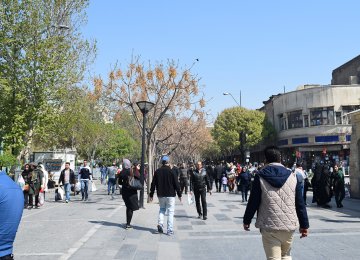The mean age has increased by 4.5 years, and the median population age by 3 years compared to 30 years ago, according to the latest census.
The nationwide census was carried out from September 24, 2016, in two stages: the first was online and the second, door-to-door registration. The latter stage ended on November 18.
An increasing median age signifies population ageing of a country due to the declining fertility rates and/or rising life expectancy.
“The mean age of the population has reached 31.1 years, and the median age 30 years from 27 in 1986,” said Alireza Zahedian, deputy head for statistical projects at the Statistical Center of Iran (SCI), at a press briefing on Wednesday, Mehr News Agency reported.
The figures stood at 25 years in the fiscal March 2006-07, according to the SCI. The census results show that female median age is 31.3 years and male median age is 30.9 years. About 44.8% of the Iranian population is between 30 and 64 years.
Mean age is the average age of the people. Median age is the point where half the population is above and half are below it. The median gives a slightly better picture of what the age distribution looks like. For instance, when the median is 35, you know that half the population is older than 35 and some things about birth rates, ages of parents, and so on can be inferred.
However, if the mean age is 35, you can’t infer much, because that figure (35) could be influenced by a large population bulge at age 70, for example, or perhaps a population gap in some age range due to an epidemic or war.
In early 2017, the SCI had reported that the national population had crossed 80 million going by the population growth rate at the time. However, the results of the latest census put the population at 79,926,270, which means the growth has not been at the expected pace.
Sharp Demographic Changes
During the tenure of the previous government (2005-2013), a report on the country’s demography suggested that the median age was expected to increase from 28 in 2013 to 40 by 2030 and that the population growth rate would decline to zero by the year 2050.
The recent census put the percentage of people between 0 and 14 years at 24% and those between 15 and 29 years at 25.1% of the total population, while 6.1% of the people are above 65 years.
The population growth rate dropped to 1.24% in 2016 from almost 4% in 1986.
“Although, the decreasing trend of population growth has been less sharp over the past few years,” Zahedian said, stressing that had the rate continued to decline at the 2010 pace (1.1%), the population growth rate would have been less than 1% now.
The rate at present is 1.3%. Between 1976 and 1986 the population grew by 1.5 million per year. Between 2007 and 2012, it grew by 930,000 annually, and the annual growth has now reached 950,000.
“The growth is not even in all provinces, and in some like North Khorasan and Hamedan, the rate is negative,” the official said.
The census put the number of men at 40,498,442 and the number of women at 39,427,828, meaning the sex ratio stands at 103:100. The previous census put the ratio at 102:100.
The current total fertility rate of 1.8 which is the lowest among Islamic countries, and even below the world average of 2.1 births per woman, is a big decline from the mid-1970s and the 1980s when it was 6.4. It is also seen as a major challenge to the national population growth rate that is 1.3%. The current global population growth rate is around 1.1%.
The sharp decline in the TFR was predicted to seriously impact the population growth rate and raise new demographic challenges, including an aging population and a shrinking labor force that by extension would encourage foreign labor to the country.






Add new comment
Read our comment policy before posting your viewpoints